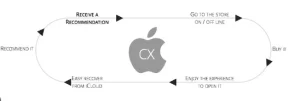User Experience Vs Customer Experience: What’s the Difference?
Today the success of a business website hinges on a single pivotal factor: user experience.
Imagine your business website as a digital storefront and user experience as the stunning window display that fascinates passersby to enter. The magical store captivates visitors, immerses them in a seamless journey, and leaves them spellbound, craving for more.
Just as a captivating story compels readers to turn each page, a remarkable user experience weaves an irresistible tale that lingers in the hearts and minds of your online visitors.
If this excites you, lets explore more in “Customer Experience VS User Experience”.
What is Customer Experience?
Customer experience refers to the overall perception and satisfaction a customer has with a company or brand based on their interactions and experiences throughout the entire customer journey.

- It encompasses every touchpoint and interaction a customer has with a business, including the pre-purchase, purchase, and post-purchase stages.
- Customer experience goes beyond just the product or service itself. It involves factors such as the ease of navigation on a website, the responsiveness of customer support, the quality of interactions with sales representatives, the speed of delivery, and the overall level of customer service.
- A positive customer experience is crucial for building customer loyalty, advocacy, and repeat business. It is achieved by delivering exceptional customer service, providing personalised and relevant interactions, meeting or exceeding customer expectations, and consistently delivering on promises.
- Businesses prioritising customer experience understand that satisfied and loyal customers can become brand advocates, promoting the business through word-of-mouth recommendations and positive online reviews.
By improving customer experience, businesses can differentiate themselves from competitors, foster long-term customer relationships, and drive growth and profitability.
Apple- Brand that offers great Customer Experience
Apple’s commitment to customer satisfaction can be seen in its products, services, and interactions.

Apple creates products known for their user-friendly interfaces, sleek designs, and seamless integration across devices. The intuitive nature of Apple devices, such as iPhones, iPads, and MacBooks, contributes to a positive user experience. The Apple products and services ecosystem allows customers to easily sync and access their content across multiple devices.
- In Apple’s retail stores, the company emphasises personalised customer service. Apple Store employees, known as “Geniuses,” are trained to provide knowledgeable assistance and support to customers. The stores offer a welcoming environment where customers can explore products hands-on and receive expert advice.
- Apple’s customer service extends beyond the physical stores, with phone, chat, and online support available. The company strives to resolve customer issues promptly and effectively, often going above and beyond to ensure customer satisfaction.
- Apple’s commitment to privacy and security is also an essential aspect of its customer experience. The company prioritises protecting customer data and provides robust security features in its devices and services, earning the trust of its customer base.
- Apple regularly updates its software and introduces new features to enhance the user experience and address customer needs. Their focus on innovation, quality, and attention to detail contributes to the overall positive perception of the brand.
- Apple’s dedication to delivering exceptional customer experience has helped them cultivate a loyal customer base and create a strong brand affinity. Their ability to combine innovative products, personalised service, and a seamless user experience has set them apart in the technology industry.
Also Read: What is UI/UX Design?
What is User Experience?
User experience (UX) refers to a person’s overall experience when interacting with a product, system, or service, particularly in digital interfaces. It encompasses all aspects of the user’s interaction, including their perceptions, emotions, and behaviours before, during, and after using a product.

Source:www.freepik.com
- User experience focuses on designing and optimising the usability, accessibility, and enjoyment of a product or service. It involves considering the user’s goals, needs, and preferences to create a seamless and satisfying experience.
- UX designers aim to make interactions intuitive, efficient, and delightful. They consider factors such as the layout, navigation, visual design, content organisation, and functionality of a digital interface to ensure it meets the needs and expectations of the target audience.
- Effective user experience design involves conducting user research, creating user personas, mapping user journeys, wireframing, and prototyping, conducting usability testing, and refining the design based on user feedback.
The goal of user experience design is to create products and services that are useful, usable, and enjoyable. By providing a positive user experience, businesses can enhance customer satisfaction, increase engagement, foster brand loyalty, and ultimately drive business success.
Airbnb- a Brand that Offers Great User Experience
One brand that is often praised for offering a great user experience is Airbnb. As a platform that connects travellers with unique accommodations worldwide, Airbnb has strongly emphasised designing a seamless and enjoyable user experience.

- The Airbnb website and mobile app provide a user-friendly interface that makes it easy for users to search, book, and manage their accommodations. The search functionality allows users to filter listings based on various criteria, such as location, price range, and amenities, enabling them to find the perfect place to stay.
- One of the critical aspects of Airbnb’s user experience is the visual storytelling it employs. Listings feature high-quality photographs and detailed descriptions, providing users with a comprehensive understanding of the accommodations before booking. Additionally, the user reviews, and ratings system helps establish trust and transparency within the community.
- Airbnb has also prioritised user safety and security. They have implemented verification processes for hosts and guests and offer secure payment options. The platform allows open communication between hosts and guests, enabling them to address any questions or concerns before booking.
- The user experience extends beyond the booking process. Airbnb offers a streamlined and user-friendly messaging system for hosts and guests to communicate, ensuring a smooth and efficient exchange of information. They also provide dedicated customer support channels to assist users throughout their journey, promptly addressing any issues or inquiries.
- Airbnb has expanded its user experience beyond accommodations. They offer curated experiences and activities that users can book to enhance their travel experience. This diversification of offerings demonstrates Airbnb’s commitment to delivering a holistic and immersive user experience.
Through its focus on user-centric design, trust and safety measures, clear communication channels, and innovative features, Airbnb has established itself as a brand that offers a remarkable user experience. Their attention to detail and dedication to creating a seamless and enjoyable platform have contributed to their success in the travel industry.
User Experience Vs Customer Experience: What is the difference?
Let us now read the difference between user experience and customer experience:
| User Experience (UX) | Customer Experience (CX) |
| Focuses on the overall experience of individual users while interacting with a product, system, or service. | Encompasses the entire journey and overall perception of customers with a company or brand. |
| Emphasises designing intuitive, efficient, and enjoyable interactions to meet the needs and expectations of users. | Aims to deliver exceptional customer service, meet or exceed customer expectations, and foster customer loyalty. |
| Considers factors such as usability, accessibility, visual design, and interaction design to create a seamless user experience. | Involves multiple touchpoints, including pre-purchase, purchase, and post-purchase stages, to ensure customer satisfaction throughout the entire journey. |
| Often associated with digital interfaces, such as websites and mobile apps. | Applies to all interactions with a company, both online and offline, including products, services, and customer support. |
| Involves user research, personas, wireframing, prototyping, and iterative design processes. | Requires understanding customer needs, preferences, and behaviours through research, feedback analysis, and continuous improvement efforts. |
| Aims to increase user engagement, satisfaction, and usability of a product or service. | Seeks to build customer loyalty, advocacy, and positive brand perception to drive customer retention and business growth. |
User Experience (UX) and Customer Experience (CX) are crucial in ensuring positive interactions and fostering long-term relationships. While UX focuses on individual users’ interactions with a product, system, or service, CX takes a broader perspective and encompasses the entire customer journey and perception of a brand.
By prioritising both UX and CX, businesses can deliver exceptional experiences that drive customer satisfaction and business success.
Conclusion
In the above topic of “Customer Experience vs User Experience”, we understand that User Experience (UX) and Customer Experience (CX) are vital in creating successful and customer-centric businesses. UX enhances individual interactions, ensuring seamless, enjoyable experiences, while CX focuses on the overall journey, aiming for customer satisfaction and loyalty. By prioritising both UX and CX, businesses can foster strong relationships and drive growth.
If you need assistance in improving your UX or CX strategies, we’re here to help. Connect with us today for expert guidance and unlock the full potential of your customer experiences.
FAQ
What is the difference between Customer Experience (CX) and User Experience (UX)?
CX refers to customers’ overall perception and satisfaction with a brand, while UX focuses on individual users’ interactions with a product or service.
Why is Customer Experience necessary?
Customer Experience is crucial as it influences customer loyalty, advocacy, and brand perception. A positive CX can drive repeat business and word-of-mouth recommendations.
What factors contribute to a good User Experience?
A good UX considers usability, accessibility, visual design, content organisation, and seamless interactions. It aims to make the user’s journey intuitive, efficient, and enjoyable.
How can businesses improve Customer Experience?
Businesses can improve CX by understanding customer needs, gathering feedback, personalising interactions, providing excellent customer service, and continuously refining their offerings based on customer insights.
What role does User Experience play in product success?
User Experience is crucial to product success as it directly impacts user satisfaction, engagement, and adoption. A well-designed UX increases the likelihood of users embracing and recommending the product.
How can businesses measure and evaluate Customer Experience?
Businesses can measure CX through various methods, including customer surveys, feedback analysis, Net Promoter Score (NPS), customer satisfaction (CSAT) surveys, and tracking customer retention and churn rates



